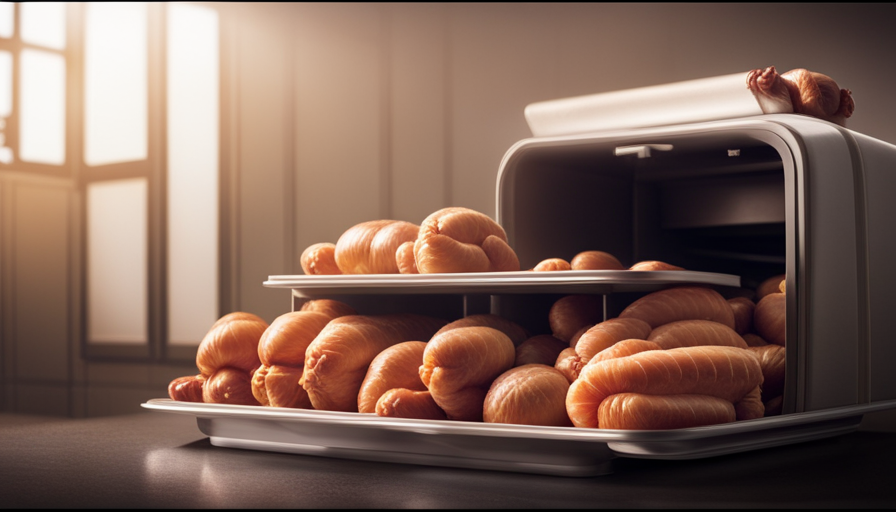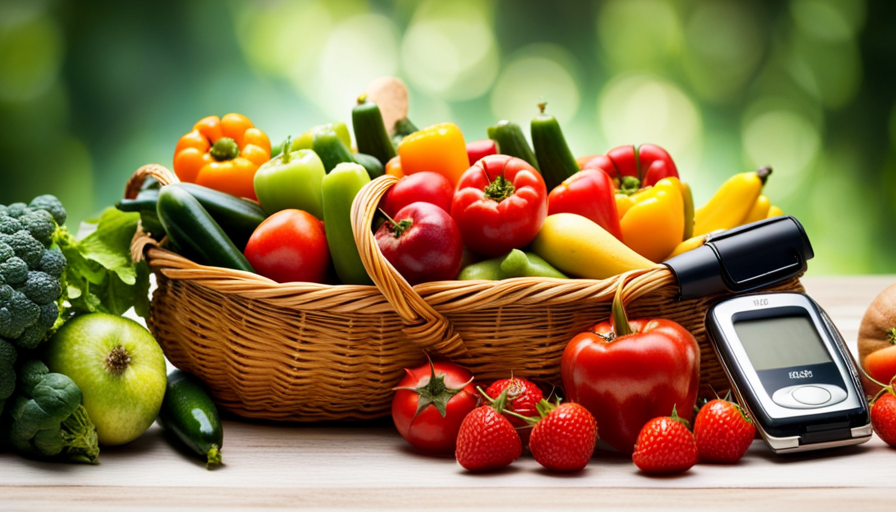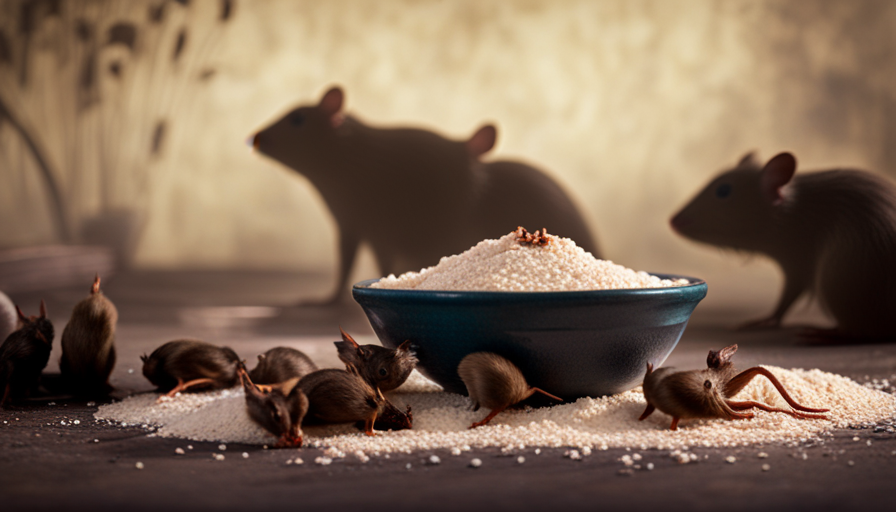Are you aware of the expression, ‘A kitchen is like a battlefield’? In terms of food safety, this statement holds true. Similar to how soldiers require a strategic plan to emerge victorious in a war, you need a solid game plan to ensure your kitchen remains safe and devoid of harmful bacteria. At the forefront of this battleground stands raw poultry.
Placing raw poultry in your refrigerator might seem like a simple task, but it’s crucial to do it correctly to prevent cross-contamination and keep your family safe from foodborne illnesses.
In this article, we will guide you through the dos and don’ts of placing raw poultry, offering expert advice and best practices to ensure that your fridge becomes a fortress against bacteria.
So, gear up and get ready to conquer the food safety battlefield!
Key Takeaways
- Raw poultry should be stored on the bottom shelf of the refrigerator to prevent cross-contamination.
- Use leak-proof packaging or containers when storing raw poultry to minimize the risk of cross-contact.
- Use separate cutting boards and utensils for raw poultry to avoid cross-contamination.
- Wash hands thoroughly after handling raw poultry to prevent the spread of bacteria.
Understanding Food Safety Guidelines
You need to understand food safety guidelines so you can make informed decisions about where to place raw poultry. Foodborne illnesses are a serious concern, and it’s crucial to take every precaution to prevent them.
Cross contact prevention is key in ensuring the safety of your food.
When it comes to placing raw poultry, it’s important to keep it separate from other foods, especially those that’ll be consumed raw or lightly cooked. Raw poultry can contain harmful bacteria such as Salmonella or Campylobacter, which can cause foodborne illnesses if not handled properly.
To prevent cross contact, it’s recommended to store raw poultry on the bottom shelf of your refrigerator. This prevents any potential drips or leaks from contaminating other foods. It’s also important to keep raw poultry in leak-proof packaging to further minimize the risk of cross contact.
When preparing raw poultry, always use separate cutting boards and utensils to avoid cross-contamination with other foods. Wash your hands thoroughly after handling raw poultry to prevent the spread of bacteria.
By understanding food safety guidelines and practicing cross-contact prevention, you can ensure the safety of your food and protect yourself and your loved ones from foodborne illnesses.
Preventing Cross-Contamination in Your Refrigerator
Safeguard against cross-contamination by segregating your uncooked chicken in a separate section of the fridge. This is crucial for preventing bacterial growth and ensuring food safety. Proper handling techniques should be followed to minimize the risk of contamination.
To prevent cross-contamination in your refrigerator, it is important to store raw poultry properly. By designating a specific area in your fridge exclusively for raw chicken, you can minimize the chances of bacteria spreading to other foods. This segregation is crucial as raw chicken can contain harmful bacteria like Salmonella or Campylobacter.
To make it easier for you to organize your fridge, here is a simple table that provides guidance on where to place different types of food:
| Section | Food Items |
|---|---|
| Top shelf | Ready-to-eat foods |
| Middle | Cooked leftovers |
| Bottom | Raw poultry |
| Door | Condiments, drinks |
Remember, the bottom shelf is where raw poultry belongs. By keeping it separate, you reduce the risk of bacteria contaminating other foods. Additionally, always ensure proper handling techniques, such as using separate cutting boards and utensils for raw and cooked foods, and thoroughly washing your hands and surfaces after handling raw chicken.
By following these guidelines, you can prevent cross-contamination and maintain a safe and healthy refrigerator environment.
Proper Storage Practices for Raw Poultry
To maintain optimal freshness and minimize the risk of contamination, it’s essential to store your uncooked chicken in a designated section of your refrigerator. Proper handling and temperature control are crucial when it comes to raw poultry.
Here are some key storage practices for raw poultry:
-
Keep it separate: Store raw poultry on the bottom shelf of your refrigerator, away from other foods. This prevents any juices from dripping onto other items and causing cross-contamination.
-
Use airtight containers: Place your chicken in a sealed container or a leak-proof bag to prevent any bacteria from spreading and to maintain its freshness.
-
Follow the ‘first in, first out’ rule: Arrange your chicken so that the oldest ones are in the front, making it easier to use them before their expiration date.
-
Monitor the temperature: Ensure that your refrigerator is set to a temperature below 40°F (4°C). This helps slow down bacterial growth and keeps your chicken safe to consume.
-
Clean and sanitize: Regularly clean your refrigerator, especially the area where you store raw poultry, with a mild soap solution or a sanitizing agent to prevent the buildup of bacteria.
By following these proper handling and temperature control practices, you can ensure the safety and quality of your raw poultry.
Separating Raw Poultry from Other Foods
Make sure your refrigerator has a designated space for your uncooked chicken to prevent any potential contamination. Separating raw poultry from other foods is crucial in preventing cross-contamination and reducing the risk of foodborne illnesses.
Raw poultry can contain harmful bacteria such as Salmonella and Campylobacter, which can easily spread to other foods if not properly handled. To separate raw poultry from other foods, store it in a leak-proof container or a plastic bag that’s tightly sealed. This will prevent any juices from dripping onto other foods and contaminating them.
It’s recommended to place raw poultry on the bottom shelf of the refrigerator to prevent any accidental drips onto ready-to-eat foods that may be stored below.
Avoid storing raw poultry near other raw meats, such as beef or pork, as they can also harbor harmful bacteria. Additionally, keep raw poultry away from fruits, vegetables, and other ready-to-eat foods to prevent cross-contamination.
Regularly clean and sanitize your refrigerator to ensure that no bacteria from raw poultry or other foods remain. Use hot, soapy water to clean surfaces where raw poultry has been stored.
By properly separating raw poultry from other foods, you can significantly reduce the risk of cross-contamination and protect yourself and your family from foodborne illnesses. Remember to always practice safe food handling and follow proper storage practices to ensure food safety.
Choosing the Right Shelf for Raw Poultry
Find the perfect perch for your uncooked chicken on a refrigerator shelf, like a safe haven for your poultry. Choosing the right shelf for raw poultry is crucial to ensure food safety and prevent the growth of harmful bacteria.
Here are four key factors to consider when placing your raw poultry in the refrigerator:
-
Temperature control: Set your refrigerator temperature to 40°F (4°C) or below to keep the raw poultry cold and slow down bacterial growth. Avoid placing it in the door shelves as they’re often exposed to warmer temperatures due to frequent opening and closing.
-
Proper packaging: Place the raw poultry in a leak-proof container or wrap it tightly in plastic wrap or aluminum foil to prevent any drips or cross-contamination with other foods. This’ll also help maintain the quality of the meat.
-
Placement: Store the raw poultry on the bottom shelf to prevent any juices from dripping onto other foods, especially those that’ll be consumed raw, such as fruits and vegetables. This’ll minimize the risk of contamination.
-
Use a tray or plate: To further prevent any potential leakage, place a tray or plate under the container or packaging of the raw poultry. This’ll catch any juices, making cleanup easier and preventing any contact with other foods.
By following these guidelines, you can ensure that your raw poultry is stored in the appropriate temperature and location, reducing the risk of bacterial growth and keeping your food safe.
Using Containers or Bags to Contain Raw Poultry
Keep your uncooked chicken contained and safe by using containers or bags when storing it in the refrigerator. This simple step can prevent cross-contamination and reduce the risk of foodborne illnesses. When it comes to choosing between containers and bags, both options have their advantages.
Containers provide a sturdy and leak-proof option for storing raw poultry. They are easy to clean and can be reused multiple times. Make sure to choose containers with tight-fitting lids to keep the chicken fresh and prevent any odors from spreading. It’s also a good idea to label the containers with the date to ensure you use the oldest chicken first.
On the other hand, bags offer convenience and flexibility. Zip-lock bags, specifically designed for storing food, can be a great choice. They are space-saving, allowing you to stack them neatly in the refrigerator. However, it is important to choose high-quality bags that are durable and can resist leaks.
Here is a table comparing containers and bags for storing raw poultry:
| Containers | Bags |
|---|---|
| Sturdy | Convenient |
| Leak-proof | Space-saving |
| Reusable | Disposable |
| Easy to clean | Durable |
Regardless of whether you choose containers or bags, there are some best practices to follow. Always keep the raw poultry on the bottom shelf of the refrigerator to prevent any drips or spills from contaminating other foods. Additionally, make sure to wash your hands thoroughly after handling raw chicken to avoid spreading bacteria.
By using containers or bags and following these best practices, you can ensure the safety of your raw poultry and protect yourself and your family from foodborne illnesses.
Cleaning and Disinfecting Your Refrigerator
After successfully storing your raw poultry, it’s essential to ensure the cleanliness and disinfection of your refrigerator. Follow these steps to maintain a safe and odor-free environment for your food:
-
Empty the refrigerator: Start by removing all items from your refrigerator, including shelves and drawers, to access every nook and cranny.
-
Use proper cleaning products: Choose a mild detergent or a mixture of water and baking soda to clean the interior surfaces. Avoid using harsh chemicals that can leave behind harmful residues.
-
Scrub and rinse: Use a sponge or cloth to scrub the walls, shelves, and drawers thoroughly. Pay extra attention to any visible spills or stains. Rinse with clean water to remove any residue.
-
Remove odors: To eliminate any lingering odors, wipe the interior surfaces with a mixture of equal parts water and vinegar. Alternatively, you can use a box of baking soda to absorb unpleasant smells.
Remember, regular cleaning and disinfection of your refrigerator is crucial to prevent the growth of harmful bacteria and maintain the freshness of your food. By following these steps and using the right cleaning products, you can ensure a safe and odor-free environment for your stored raw poultry and other perishable items.
Storing Raw Poultry in the Freezer
To ensure a delightful dining experience, let’s delve into the art of safely storing raw poultry in the freezer. Proper freezing techniques and defrosting methods are crucial in maintaining the quality and safety of your poultry.
When it comes to freezing raw poultry, it’s essential to follow these guidelines:
-
Use freezer-safe packaging: Make sure to transfer the poultry into airtight containers or heavy-duty freezer bags to prevent freezer burn and contamination.
-
Label and date: Clearly label the packages with the type of poultry and the date of freezing. This will help you keep track of the freshness and determine the order in which to use them.
-
Keep a consistent temperature: Set your freezer temperature to 0°F (-18°C) or lower. This ensures that harmful bacteria cannot grow and spoil your poultry.
When it’s time to defrost your frozen poultry, it’s important to do it safely to avoid the risk of foodborne illnesses. Here are two recommended methods:
-
Refrigerator thawing: Place the frozen poultry on a tray in the refrigerator and allow it to thaw slowly. This method takes longer but ensures a more even thaw without compromising the quality.
-
Cold water thawing: If you need to defrost the poultry quickly, submerge it in a leak-proof plastic bag in cold water. Change the water every 30 minutes to maintain a safe temperature.
By following these freezing techniques and defrosting methods, you can enjoy delicious, safe poultry for your meals. Remember, proper handling and storage are essential when it comes to raw poultry.
Labeling and Organizing Your Refrigerator
Make sure you take a moment to organize your refrigerator, so you can easily find what you need and create a visual masterpiece of perfectly arranged items that’ll make your friends green with envy.
Start by labeling containers to keep track of their contents. This simple step will save you time and prevent any confusion when searching for specific items. You can use adhesive labels or a marker to clearly mark each container with its contents, such as leftovers, sauces, or snacks.
Next, focus on organizing your condiments. These little bottles and jars can easily get lost in the chaos of your refrigerator. Arrange them in a designated section, preferably on the door where they’re easily accessible. Group similar condiments together, like ketchup, mustard, and mayonnaise, so you can quickly grab what you need for your favorite dishes.
Consider using clear storage bins to further enhance your organization. These bins can be used to group similar items, such as fruits or vegetables, and prevent them from rolling around and causing a mess. Additionally, they make it easier to see what you have and avoid any unnecessary food waste.
By labeling containers and organizing your condiments, you’ll create a visually appealing and functional refrigerator. You’ll be able to locate items with ease and impress your friends with your organizational skills. So take a few moments to implement these tips and transform your refrigerator into a well-organized haven of deliciousness.
Best Practices for Handling Raw Poultry Safely
Ensure your hands are thoroughly washed before handling the juicy, tender chicken to maintain a safe and sanitary cooking environment. When it comes to handling raw poultry, it is crucial to follow best practices to prevent foodborne illnesses. One important aspect is to have separate preparing utensils for raw poultry to avoid cross-contamination. This means using different cutting boards, knives, and plates for raw poultry compared to other foods.
Additionally, it is essential to cook raw poultry at the correct temperature to kill any harmful bacteria. The USDA recommends cooking chicken to an internal temperature of 165°F (74°C). Using a food thermometer is the most accurate way to determine if the chicken is fully cooked. Insert the thermometer into the thickest part of the meat, avoiding bones, and ensure it reaches the recommended temperature.
To help you visualize the importance of proper handling and cooking, here is an emotional table:
| Scenario | Consequence | Solution |
|---|---|---|
| Cross-contamination | Risk of foodborne illnesses | Use separate utensils for raw poultry |
| Undercooked chicken | Bacterial contamination | Cook chicken to an internal temperature of 165°F (74°C) |
| Improper storage | Spoiled chicken | Store raw poultry in the coldest part of the refrigerator |
By following these guidelines, you can ensure the safety of your food and create delicious meals with properly handled and cooked raw poultry.
Frequently Asked Questions
How long can raw poultry be stored in the refrigerator before it needs to be cooked or frozen?
Raw poultry can be stored in the refrigerator for up to 2 days before it needs to be cooked or frozen. To ensure proper storage, follow these poultry storage tips:
- Keep the poultry in its original packaging or place it in a leak-proof plastic bag to prevent cross-contamination.
- Store the poultry on the bottom shelf of the refrigerator to prevent any juices from dripping onto other foods.
Remember, proper refrigerator organization is essential for food safety.
Is it safe to store raw poultry on the top shelf of the refrigerator?
Storing raw poultry on the top shelf of the refrigerator is like putting a lion in a cage made of toothpicks – it’s a recipe for disaster! Proper handling of raw poultry is crucial to prevent cross-contamination. Always keep it separate from other foods, preferably in a leak-proof container on the bottom shelf.
The ideal storage temperature for raw poultry is below 40°F (4°C). Following these precautions will help ensure the safety of your food and prevent foodborne illnesses.
Can raw poultry be stored with other raw meats in the refrigerator?
When it comes to storing raw poultry, it’s important to handle it properly to avoid cross-contamination. Keep raw poultry separate from other raw meats in the refrigerator to prevent the spread of bacteria. Store it on the lowest shelf to prevent any juices from dripping onto other foods. Always use sealed containers or leak-proof bags to contain the raw poultry and clean any surfaces or utensils that come into contact with it. Follow these raw poultry storage tips for a safe and hygienic kitchen.
What should I do if raw poultry juices accidentally come into contact with other foods in the refrigerator?
To prevent cross contamination in the refrigerator, immediately remove any food that’s come into contact with raw poultry juices. Dispose of the contaminated food and thoroughly clean the area with hot, soapy water.
Next, disinfect the refrigerator using a solution of one tablespoon of bleach mixed with one gallon of water. Wipe down all surfaces, including shelves and drawers.
Remember to wash your hands thoroughly after handling raw poultry to avoid spreading bacteria.
How often should I clean and disinfect my refrigerator to prevent cross-contamination with raw poultry?
To prevent cross-contamination with raw poultry, it’s crucial to clean and disinfect your refrigerator regularly. Aim for a cleaning frequency of once every week or two.
When cleaning, use the best cleaning products available, such as bleach-based cleaners or disinfectant wipes. These products effectively kill bacteria and other pathogens that may contaminate your fridge.
By maintaining a clean refrigerator, you can minimize the risk of foodborne illnesses and ensure the safety of your food.
What is the Proper Way to Store Raw Poultry in a Food Handling Environment?
When it comes to proper food handling, it’s crucial to know how to rack raw food, especially raw poultry. Store raw poultry on the bottom shelf of the refrigerator to prevent any potential cross-contamination. Keep it securely wrapped or in a sealed container to avoid any drips or spills.
Conclusion
So there you have it! By following proper storage practices and separating raw poultry from other foods, you can ensure the safety of your refrigerator and prevent cross-contamination. Remember to choose the right shelf for raw poultry and clean your refrigerator regularly to maintain a hygienic environment.
Additionally, storing raw poultry in the freezer and labeling and organizing your refrigerator will help you keep track of your food and prevent any mishaps. By handling raw poultry safely, you can enjoy delicious meals without compromising your health.
Stay informed and take the necessary precautions, and you’ll be on your way to a safer kitchen.










